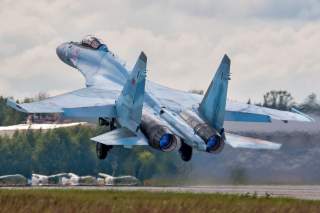The Biggest Threat To Russia's Su-57 Comes From... Within The Russian Air Force?
The Su-35 is too good.
Key point: The Su-35S continues to occupy the upper echelons of Russian aerospace design as the VKS’ top air superiority fighter.
“A unique machine, a deadly aerial fist,” is how the official television channel of the Russian Ministry of Defense introduced the Su-35S superiority fighter earlier this week.
TV Zvezda’s three-minute clip of a recent Su-35S training sortie over Syria provides close-up shots of the fighter jet being prepped for flight, taking off, cruising over the Syrian coast, and firing flares. On their youtube account, they published slightly extended footage of the same exercise.
The first Su-35S fighters arrived at Russia’s Khmeimim Air Base in 2016, relatively late into the Syrian Civil War. They performed well in their role of covering for Russian ground-strike aircraft during bombing missions against Syrian opposition targets, but then again-- there were no immediate airspace threats facing the Russia’s Syrian forces in early 2016. The Su-35S was therefore limited to an air deterrence role amid an ongoing diplomatic row between Moscow and Ankara that wound down only in the latter half of 2016.
Today, airpower continues to be the crucial military ingredient in the enforcement of Russian “de-escalation zones” strewn across the western parts of Syria, and in intermittent bombing runs against opposition stragglers and ISIS targets.
From the conflict’s earliest days through 2019, the Syrian venture continues to yield military value as a training and proving grounds for the next generation of Russian servicemen. As a Su-35S pilot told Zvezda, “here, we can realize the potential of the aircraft-- the tactical potential. For every pilot and co-pilot, this is a tremendous opportunity to hone their skills.” In a less covered but no less important development, it also provides Russian engineers with aircraft maintenance know-how after real, albeit low-intensity, combat missions.
Barring a brief and nondescript Su-57 outing, the Su-35S is among the most advanced Russian military aircraft to be deployed in Syria. As a deep modernization of the prolific Soviet-era Su-27 fighter, the Su-35S boasts updated avionics (onboard electronics), a new lightweight frame, and 3d thrust vectoring capability, and vastly more expanded armament suite. Notably, the latter includes Vympel R-77 air-to-air missiles that are meant to compete favorably with the US AIM-120 AMRAAM platform, and an air-launched anti-ship variant of Russia’s prolific Kalibr cruise missiles.
The Su-35S was intended as an interim solution; as a modernized air superiority fighter to sustain the Russian Aerospace Forces (VKS) through the 2010’s until the Su-57 fifth-generation stealth fighter enters serial production. But the Su-35S was almost too successful for its own good, ticking so many performance and role versatility boxes that it seems to cannibalize its more expensive Su-57 successor. In the short term, it’s likely true that there will be a minimal operational difference between the latest Su-35S units and the first serially-produced Su-57’s. As it currently stands, there is even a chance that the two fighters may use the same AL-41F1 engine.
But as is typically the case with next-generation platforms, the VKS is not concerned with immediate value. Rather, they see the Su-57 as a long-term investment that will incrementally phase out older aircraft to become Russia’s staple air superiority platform over the coming decades. In the meantime, the Su-35S continues to occupy the upper echelons of Russian aerospace design as the VKS’ top air superiority fighter.
Mark Episkopos is a frequent contributor to The National Interest and serves as research assistant at the Center for the National Interest. Mark is also a PhD student in History at American University. (This first appeared last year.)
Image: Wikipedia.

